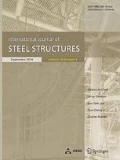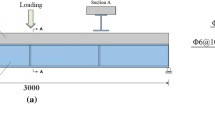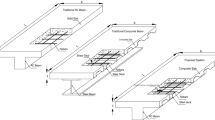Abstract
Modern construction makes frequent use of composite steel-concrete beams for bridge and building applications. This paper describes a three-dimensional finite element model in which all components forming the composite member are modelled by means of solid elements. The proposed approach is developed using the commercial software Abaqus and is able to model the composite response without requiring information from push-out tests commonly performed to define the constitutive relationship for the shear connectors. All materials are assumed to behave in a nonlinear fashion. Contact between the elements is simulated using surface-to-surface and embedment techniques. The adequacy and accuracy of the proposed modelling approach are validated against experimental results available in the literature on simply-supported and continuous beam tests with both solid and composite slabs.
Similar content being viewed by others
References
ABAQUS (2008). ABAQUS User’s Manual. Version 6.8 EF-2, Dassault Systèmes Simulia Corp., Providence, RI, USA.
Baskar, K, Shanmugam, N. E., and Thevendran, V. (2002). “Finite-element analysis of steel-concrete composite plate girder.” Journal of Structural Engineering, 128(9), 1158–1168.
Bradford, M. A., Filonov, A., Hogan, T. J., Ranzi, G., and Uy, B. (2006). “Strength and ductility of shear connection in composite T-beams.” Proc. the Eighth International Conference on Steel, Space and Composite Structures, Kuala Lumpur, Malaysia, pp. 15–26.
Bruneau, M., Uang, C. M., Whittaker, A. (1998). Ductile Design of Steel Structures. McGraw-Hill, New York.
Chapman, J. C. and Balakrishnan, S. (1964). “Experiments on composite beams.” The Structural Engineer, 42(11), pp. 369–383.
El-Lobody, E. and Lam, D. (2003). “Finite element analysis of steel-concrete composite girders.” Advances in Structural Engineering, 6(4), pp. 267–281.
El-Lobody, E. and Young, B. (2006). “Performance of shear connection in composite beams with profiled steel sheeting.” Journal of Constructional Steel Research, 62(7), pp. 682–694.
EN 1994-1-1 (2004). EUROCODE 4: Design of composite steel and concrete structures — Part 1-1: General rules and rules for buildings. European Committee for Standardization.
Fu, F., Lam, D., and Ye, J. (2007). “Parametric study of semi-rigid composite connections with 3-D finite element approach.” Engineering Structures, 29, pp. 888–898.
Lam, D. and El-Lobody, E. (2005). “Behaviour of headed stud shear connectors in composite beam.” Journal of Structural Engineering, 131(1), pp. 96–107.
Leon, R. T. and Viest, I. M. (1996). “Theories of incomplete interaction in composite beams.” Proc. Conference on Composite Construction in Steel and Concrete III, Irsee, Germany, pp. 858–870.
Mirza, O. and Uy, B. (2010). “Effect of combination of axial tensile and shear loading on the behaviour of headed stud steel anchors.” Engineering Structures, 32, pp. 93–105.
Newmark, N. M, Siess, C. P., and Viest, I. M. (1951). “Tests and analysis of composite beams with incomplete interaction.” Proc. the Society of Experimental Stress Analysis, 9(1), pp. 75–92.
Nie, J., Fan, J., and Cai, C. S. (2008). “Experimental study of partially shear-connected composite beams with profiled sheeting.” Engineering Structures, 30, pp. 1–12.
Nie, J., Fan, J., and Cai, C. S. (2004). “Stiffness and deflection of steel-concrete composite beams under negative bending.” Journal of Structural Engineering, 130(11), pp. 1842–1851.
Nguyen, H. T. and Kim, S. E. (2009). “Finite element modeling of push-out tests for large stud shear connectors.” Journal of Constructional Steel Research, 65, pp. 1909–1920.
Queiroz, F. D., Vellasco, P. C. G. S., and Nethercot, D. A. (2007). “Finite element modelling of composite beams with full and partial shear connection.” Journal of Constructional Steel Research, 63(4), pp. 505–21.
Qureshi, J., Lam, D., and Ye, J. (2011). “Effect of shear connector spacing and layout on the shear connector capacity in composite beams.” Journal of Constructional Steel Research, 67, pp. 706–719.
Ranzi, G., Bradford, M. A., Ansourian, P., Filonov, A., Rasmussen, K. J. R., Hogan, T. J., and Uy, B. (2009). “Full-scale tests on composite steel-concrete beams with trapezoidal decking.” Journal of Construction Steel Research, 65, pp. 1490–1506.
Smith, A. L. and Couchman, G. H. (2010). “Strength and ductility of headed stud shear connectors in profiled steel sheeting.” Journal of Constructional Steel Research, 66, pp. 748–754.
Spacone, E. and El-Tawil, S. (2004). “Nonlinear Analysis of Steel-Concrete Composite Structures: State of the Art.” Journal of Structural Engineering, 130, pp. 159–168.
Thevendran, V., Chen, S., Shanmugam, N. E., and Liew, J. Y. R. (1999). “Nonlinear analysis of steel-concrete composite beams curved in plan.” Finite Elements in Analysis and Design, 32, pp. 125–139.
Author information
Authors and Affiliations
Corresponding author
Additional information
Note.-Discussion open until August 1, 2012. This manuscript for this paper was submitted for review and possible publication on May 26, 2011; approved on February 6, 2012.
Rights and permissions
About this article
Cite this article
Tahmasebinia, F., Ranzi, G. & Zona, A. Beam tests of composite steel-concrete members: A three-dimensional finite element model. Int J Steel Struct 12, 37–45 (2012). https://doi.org/10.1007/s13296-012-1004-3
Published:
Issue Date:
DOI: https://doi.org/10.1007/s13296-012-1004-3




